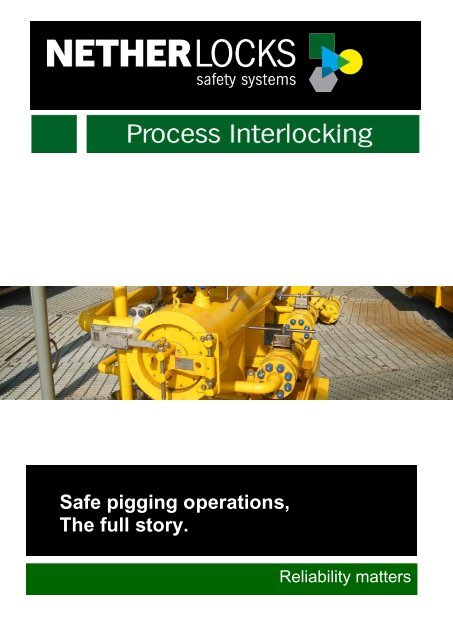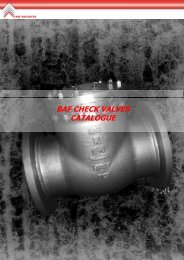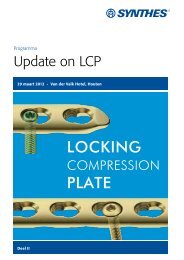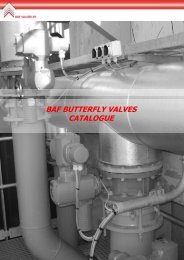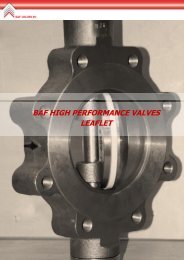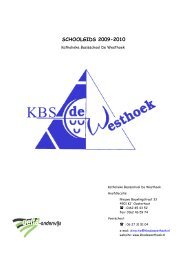Safe pigging operations, The full story.
Safe pigging operations, The full story.
Safe pigging operations, The full story.
- No tags were found...
Create successful ePaper yourself
Turn your PDF publications into a flip-book with our unique Google optimized e-Paper software.
<strong>Safe</strong> <strong>pigging</strong> <strong>operations</strong>,<strong>The</strong> <strong>full</strong> <strong>story</strong>.Reliability Reliability matters matters
Pigging Systems:Pigging <strong>operations</strong> have been recognized in the industryas a highly dangerous procedure. A slight mistake or lackin concentration could result in a disastrousconsequence.A few examples of incidents which could occur andunfortunately do are listed below. Closure door is opened, while pressure still possiblyremains inside the vessel. Main process valve is opened, while the closuredoor is still not yet <strong>full</strong>y or properly closed. Closure door is opened, while a high concentration level of H2S or other toxins stillremain inside the vessel. Vent valve remains open, while the vessel is being pressurized with its medium.<strong>The</strong> operation of the various valves and closure door involved in achieving this looks simple,but they’re often tied to a complex non-linear process sequence. Plus as stated early, there isalways the added danger of high pressure and the various mediums containing high levels ofH2S or other toxins.<strong>The</strong>se dangers are acknowledged; therefore the “BS 8010 Code of Practice for PipelinesRecommendations” recommends the use of mechanical interlocking systems on all criticalitems around the vessel (Part 2 1992 – section 2.8 & Part 3 1993 – section 6.6). Furthermore,ASME VIII – Division 1 mentions the effective safety solution with the use of interlocks.Mechanical InterlocksAn interlock guides the operator through the sequencewith unique keys for each step. It is only when amistake is made that the operator will not be allowed toproceed – a key will not fit or a valve will be locked inposition.<strong>The</strong> principle of mechanical key interlocking is thetransfer of keys. Each lock is executed with two keys:one for the locked open position and one for the lockedclosed position. When the valve is open the “open” keyis released, can be removed ready to operate the next lock in the sequence, which will sharethe same code. All keys are unique and depending on the sequence NETHERLOCKS willdetermine the codes to guarantee the required sequence.NO interference in procedure:Often there is a misconception that mechanical interlocking interferes with the standardswitch over procedures of systems, please note; THIS IS NOT TRUE.Key interlocking switch over procedures are based on a “one free key” principle. <strong>The</strong> keywhich you have in your hand is released and fits only in its dedicated valve interlock orclosure door at its correct time in its procedure.
Closure doors and bleed bolts:People have the impression that a bleed bolt on a closuredoor is a more than adequate safety precaution, to avoidany incidents. However, what function does the bleed bolthave if the door is already open?It cannot stop anybody from opening the main, kicker or adrain valve now by mistake at this point.Key can only be freed whenthe door is <strong>full</strong>y closedWith an interlocking system installed, it is not possible tooperate any process valve while the closure door is stillopen or not in its <strong>full</strong>y locked closed position. This isbecause the start key to start the sequence in unlockingthese various valves is currently trapped in the closuredoor lock.Key is trapped while the doorIs openVent and Drain:To ensure the safety of the operators while opening a closure door, the vessel involvedneeds to be vented, drained, purged and isolated from the main process line. As differentvessels and also clients have different procedures, it is therefore a good HSE practice tohave mechanical interlocking mounted onto all these critical valves.Now all valves involved shall only be operated according to its written procedure, thus givingthe assurance before any breaking of confinement that the vessel is clear of any pressureand possible toxins. We should realize that 0.1 of a bar (equal to 10.000 N/m2) could kill anoperator.Note: Operators should still always check the pressure gauge which is installed on the vesselor attach a temporary gauge; this is to confirm no pressure remains. If there is a sign ofpressure re-building back up, it means that a valve somewhere in the sequence is passing.
Sequence Procedures:It goes without saying, H2S is extremely dangerous. WhenH2S is trapped inside a vessel, you need to purge in orderto remove it. <strong>The</strong> volume of the vessel and the H2S contentdetermines how many times purging should take place.Very often, you will need to vent and purge at least 7 timesbefore it’s safe to open the closure door.How can we guarantee that a written procedure isfollowed?<strong>The</strong> answer to this question is simply by usinga MPCU, a Mechanical Process KeyExchange Unit.Ball valve with anInterlock installedNetherlocks have designed the MPCU(mechanical process control unit – amechanical PLC) to assist the operator in thefield, but to also assure that the operator isfollowing the correct procedure and not takingany short cut’s. For example if you have topurge a system 7 times, we program into theMPCU that this has to be done, so you cannotskip these steps.Procedures are written for a reason, onebeing the safe operation and workingenvironment of a plant, but sometimes thesewritten procedures can lead to the work takinglonger. As we’re all human, it is within ournature to try and take a short cut in which wecould cut down on the work and time involved.A pig launcher with interlockinginstalled and a MPCUBut when using an MPCU, each step in awritten procedure must be followed. This then keeps the integrity of the plant and the safetyof the operator priority.Shown above, are mechanical interlocks with a MPCU as an intergraded part of a launcher orreceiver skid.
So how do we achieve this?<strong>The</strong> mechanical process control unit (MPCU) is a step-by-step key exchange system whichguides the operator through the complicated procedures involved. For example on piglaunchers& receivers or non-linear heat exchange units.In order to achieve this, Netherlocks mechanically programs the written procedure of theapplicable vessel into our MPCU design. So now only at the correct time in a particularsequence, shall the correct key be freed to make the necessary next step.A Mechanical Process Control Unit<strong>The</strong>re is No extra work involved for theoperator when using this system, just theconfirmation that the correct step hasbeen made.<strong>The</strong> knob on the top of the MPCU canonly be rotated when the appropriate keyhas been inserted. 100% error free, evenan operator with less field experience canfollow these steps quickly and easily.<strong>The</strong>refore, a seven step cycle purge-ventoperation must be followed, as the MPCUdoes not allow you to skip these.If sometimes more purging cycles arerequired. We’ve incorporated into ourdesign, an option where it is possible torepeat further extra purge-vent<strong>operations</strong>, but not less.Features: All MPCU- components are made of stainless steel AISI 316 Maintenance-free design Tamperproof Tested to work in the most extreme operating environmentsOptional: <strong>The</strong> Integration of electronics like limit & proximity switches, solenoids etc.. <strong>The</strong> mounting of the MPCU into a lockable cabinet for further security and protection.(Stainless steel or epoxy-coated steel available)
A simple Pig launcher & Receiver sequenceNORMAL OPERATION<strong>The</strong> pig trap is isolated from the main flow line. KeyA, which starts the sequence is in its key cabinetlocated in the control room, stating normaloperation.PSVCVENTBCONTROL ROOM:AMAINCLOSUREEPIG LAUNCHER / RECEIVERDRAINKICKERDFTHROTTLESTEP 1:loading the pigTo begin the launch sequence, key A must beissued from the control room. With this key, thevent can be opened, releasing key B. This key isused to close the PSV, which releases key C.This key is used to open the drain to clear thevessel from any liquids. At this point the door canbe opened with key D and the pig can be loaded.Closing the door releases key D again, then thesequence must be repeated backwards to makesure the drain is closed, the PSV is open and thevent is closed. Key A is necessary to continue.PSVCCLOSUREKICKERFVENTBPIG LAUNCHER / RECEIVERDRAINDCONTROL ROOM:AMAINETHROTTLE
STEP 2: Launching the pigTo launch the pig, key A is used to open the mainvalve. This releases key E, which is used topressurize the pig launcher by opening the kickerline. After the kicker line is opened, the throttlevalve is used to restrict the flow in the mainline,by slowly closing it. This causes the pressurebehind the pig to rise until the pig is launched intothe mainline. After opening the throttle again, thekicker line and the main valve are closed,releasing key A, which will be used again todepressurize the vessel?PSVCCLOSUREKICKERVENTBPIG LAUNCHER / RECEIVERDRAINDCONTROL ROOM:AMAINEFTHROTTLESTEP 3:depressurizing the vesselAfter the pig is launched, the vessel mustbe depressurized again to avoidhazardous situations. This sequence ismostly the same as step 1, except thatit’s not necessary to open the door.After the drain is opened and closedagain, the PSV must be opened and thevent must be closed to release key A,which is returned to the control room asan indication that the pig is launched andthe system is back on normal operation.PSVCCLOSUREKICKERFVENTBPIG LAUNCHER / RECEIVERDRAINDCONTROL ROOM:AMAINETHROTTLEPlease Note: It is also possible to interlock the throttle valve, into the abovesequence. An MPCU device would be used in the above sequences to guideand check that the correct sequence of events is or has taken place.
Various Examples of MPCU’sMechanical Process Control Units
Procedure Continuation:Launching the pigInsert key A in the main isolation valve, open and release key EInsert key E in the kicker line valve, open and release key FVessel is now pressurized and ready for launchingInsert key F in the throttle valve, slowly close until the pig is launchedAfter the pig is launched, open the throttle valve and release key FIsolation and depressurizing of the vesselInsert key F in the kicker line valve, close and release key EInsert key E in the main isolation valve, close and release key AInsert key A in the PSV block valve, close and release key BInsert key B in the vent valve, open and release key CInsert key C in the drain valve and openAfter draining all residual fluids, close the valve and release key CInsert key C in the vent valve, close and release key BInsert key B in the PSV block valve, open and release key AReturn key A to the control roomLocks for electric or pneumatic actuatorsAbove we discussed hand operated valves, however locks are applicable for any type of valve,irrespective the operation; manually, pneumatic, hydraulically or electrically actuated.In all circumstances locks guarantee that a certain position of a valve or door is reached before thenext step can be made. Furthermore, it can be adapted to control the power source. <strong>The</strong>refore, whena key is released; the power supply is cut off.
KMS:To work more efficiently and to assist your plant operators further with the operation of thelarger valves or high rotation valves, which can often be found located around a piglauncher/receiver. Netherlocks have the KMS, a hand held portable actuator.– PORTABLE AIR DRIVEN VALVE ACTUATOR –<strong>The</strong> KMS is a time- and cost saving device. For valvestakingUp to 4 man hours to open and close, the KMS actuator willPerform the same work in 10 minutes with only oneoperator.Since it’s an air driven actuator, it can be used throughout aprocess plant and even in an offsite location, where aprocess air supply is available.<strong>The</strong> universal mountable driveplate assures that the actuatorcan be used on all types of valves. <strong>The</strong> actuator has anadjustable air-in twisting handle/valve. It is reversible also (adead man’s handle for HSE).For a proper storage we can provide a special box with anintegrated air filter, lubrication device, automatic hose reeland reduction valve to adjust speed and torque. It is to bestationary stored by the air outlet.Technical detailsType Air consumption Speed without <strong>Safe</strong> operating Recomm Torque at recom(l/min) load (turns/min) pressure (Bar) Pressure (Bar) pressure (Nm)101 100 1860 75 4-7 6,2 480102 000 780 136 4-7 6,2 120


